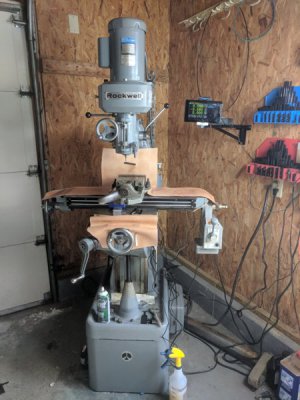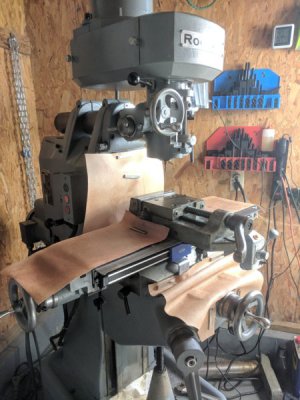- Joined
- Feb 2, 2017
- Messages
- 1,236
I’m jealous! Would love to get a machine like this. Great videos, too.Hey all! First post, first mill. I'm brand new to machining and recently picked up a mill from my local craigslist: a Rockwell 21-122 Horizontal/Vertical mill.
View attachment 250174View attachment 250175
View attachment 250177View attachment 250176
I purchased it from an estate sale, and it appears the previous owners took great care of it. The ways are all in great shape, the various moving components actuate smoothly, looks like ~10 thou backlash on x-axis, the table has seen better days but doesn't have any major gouges, etc. There's a layer of dust, grime and rust in places but nothing terrible.
The only major flaw on arrival was the quill, which didn't fully retract into the head. It felt like there is some kind of blockage in the rack/pinion gearing near the 1" mark which simply prevented it from retracting fully. The spindle bearings also felt a bit rough.
The mill also came with a ton of tooling, including an extra power feed, three vices, a rotary table, and assortment of end mills, taps, drills, punches, files, and a boring head. It also came with the important horizontal accessories, namely the overarm support, a tool arbor and spacers..
View attachment 250178
Because I'm new to machining, and the mill is in relatively good condition, I really don't want to mess it up View attachment 250179 I originally planned to do a full rebuild and scrape ways, re-align, etc. But I've re-considered my skill and the amount of work... and honestly the mill looks to be in good shape and will be fine for me as a beginner.
So instead I'm just doing a clean/repaint/re-assemble. My main objective was to get at the spindle bearings to see if they needed replacing. Also to address the quill travel problem. The paint overall was in pretty good condition... but there were a few areas where it had flaked badly and was rusting. So I'm just going to repaint the whole mill so everything matches.
I decided this would be a fun project to try my hand filming, so I've been shooting a lot of footage of the clean/repaint. Here are the first two episodes:
This video has an overview/walkaround of the mill, some fooling around with cutting aluminum scrap, then disassembling and cleaning the vertical head.
This video is mostly cleaning/stripping the fiddly bits of the vertical head; the fine feed control, the head rotation mechanism and the pulley/brake assembly.
I think there will probably be one or two more videos. I have a bunch of footage of removing the table, stoning it, etc. Also stripping the body + masking + spraying, then re-assembly. I'll post those up once I get the footage edited together.
Last edited:


